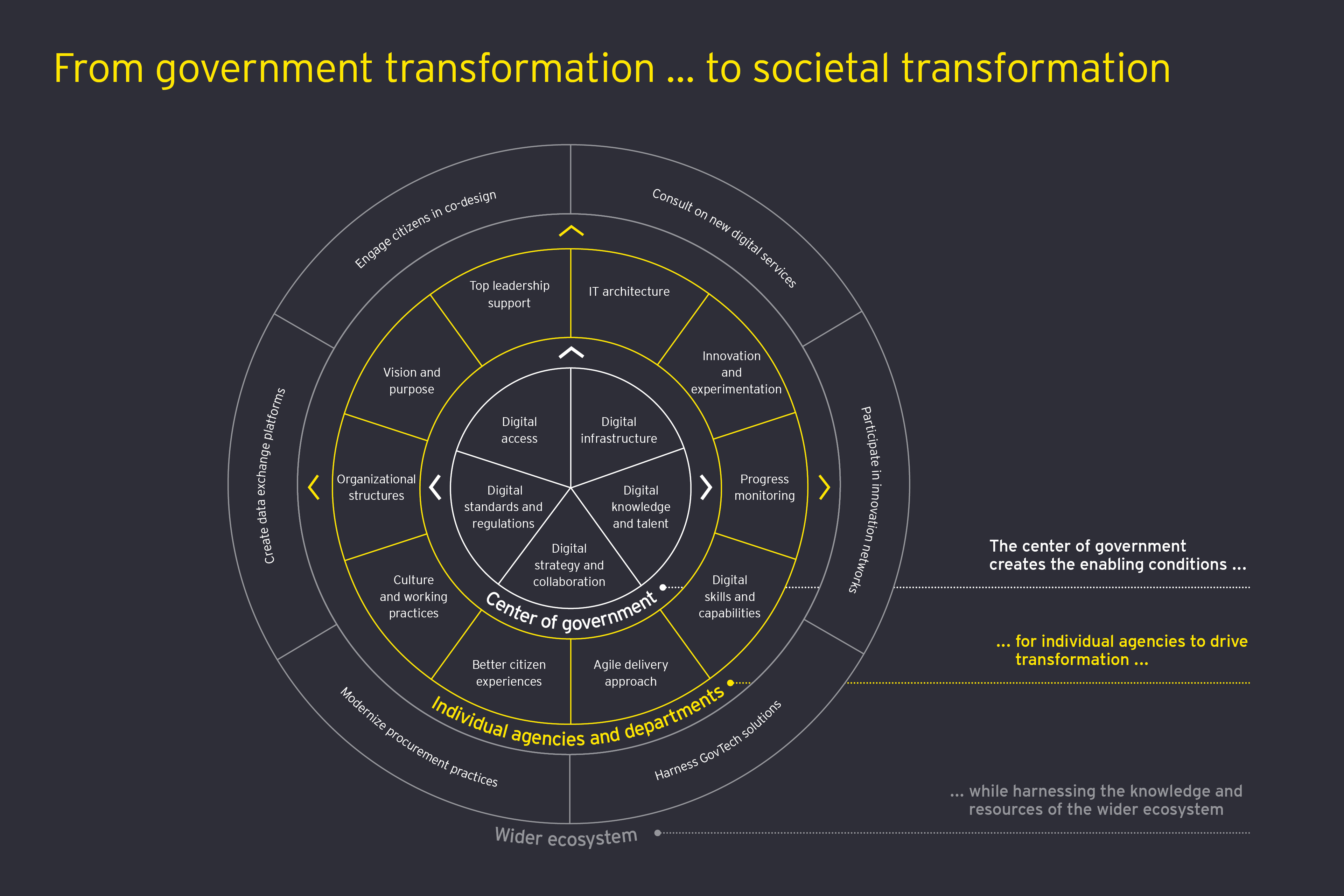
Chapter 1
The center of government must create the right environment
Central government can set the enabling conditions for digital transformation.
The center of government must create the enabling environment for a thriving digital economy while also supporting individual government departments with their own transformation efforts. This requires a focus on five key areas: digital infrastructure, digital strategy, digital access, digital standards and digital talent.
Creating digital infrastructure and fostering inclusion
To promote the development of the digital state, a high-speed, reliable digital infrastructure is required. Advanced telecom networks – including enhanced 4G and 5G mobile networks – and data centers are the backbone of a digital economy.
Given the high development costs, government agencies are increasingly teaming up with private partners to put this infrastructure in place. The COVID-19 pandemic heightened the need for this investment, sharply increasing the demand for connectivity to underpin remote working, e-commerce and service delivery.
Infrastructure improvements must address urban-rural and economic divides to achieve inclusive digitalization. Governments can also help by providing devices (such as laptops and tablets) to get people online, backed up by support and training for individuals to improve digital literacy. But offline channels will remain vital to ensure all citizens retain equal access to public services.
Driving a national digital strategy
The center of government can formulate a national digital strategy detailing how it plans to deliver efficient and accessible public services while optimizing the citizen experience. Such strategies help to ensure that individual departments and agencies are focused on government-wide outcomes, enabled by interdepartmental collaboration and funding. Many countries have created a centralized digital service or transformation office to lead their efforts.
The center of government must also consider how to address the evolving cybersecurity threats that are transforming the risk environment and threatening the democratic process itself. A national strategy and dedicated entity can help to coordinate cybersecurity efforts across government, while collaboration with other actors will help create a more secure ecosystem.
How EY can help
Government & Public Sector services
Our Government & Public Sector community brings together more than 20,000 EY people from over 100 countries. All of us share a passion to help governments work better for their people.
Read moreFacilitating seamless digital access to services
The center of government plays a crucial role in breaking down silos and achieving interoperability of different systems, databases and registers to provide one-stop access to public services. Common IT platforms should be configured to slot into the services of any agency, providing a range of applications and services such as identity management, payments, messaging and notifications.
Government must also create the means for citizens to access services through secure digital user identification and authentication systems. Different countries deploy different credentials to authenticate individuals, including unique ID numbers, mobile IDs, e-ID cards and digital identity certificates that enable parties to sign legal documents electronically. The sophistication of these ID systems is constantly evolving, as new technologies (such as facial recognition), regulations and standards come into play.
Setting and enforcing digital policies, regulations and standards
The center of government must set and enforce appropriate laws, regulations, policies, guidelines and standards that allow innovation to flourish, while managing potential risks in the deployment and application of technologies. They must also be ready to adapt regulation, when needed, to take account of changing circumstances.
Common standards for interoperability need to be set and enforced to enable data sharing across organizations. Many governments are strengthening regulations on the use of individuals’ personal data to protect their privacy and give them more control over the way it is used.
Securing the right digital knowledge and talent
Intergovernmental collaboration and the exchange of knowledge and expertise across national borders is vital, as we have seen during the pandemic. The Digital Nations (formerly D9 group of nations) – the UK, Estonia, South Korea, Israel, New Zealand, Canada, Uruguay, Mexico and Portugal – meet regularly to disseminate best practice and develop solutions to common stumbling blocks.
The public sector must be able to compete with the private sector to recruit, train and retain the best talent. The center of government can help prepare the workforce for the digital age by building core technical skills such as software development and systems architecture, as well as new skills such as data science. As governments gradually build a more dynamic environment, they will attract younger workers and millennials in search of roles where they can make a difference to society.
Digital transformation also has wider implications for the future of work in general, and central governments need to consider the impact of automation on society, equality and employment. They should focus on developing the skills of the wider population to maintain employment opportunities.

Chapter 2
Agencies and local government must drive the transformation
Here are 10 key considerations for government agencies and departments embarking on a digital transformation.
Individual government agencies and departments are responsible for driving digital transformation within their own organizations. The following 10 actions will be critical considerations.
1. Align digital plans with overall vision and purpose
Start by considering the organization’s core purpose. Create a vision of desired outcomes around which all senior stakeholders can align, then assess the role that digital technologies can play. Some organizations start by analyzing their biggest challenges, which enables them to identify and prioritize projects for early digitalization. A recent EY survey, for example, revealed that almost two-thirds of respondents have increased their use of digital and data solutions in response to COVID-19 challenges.
Develop a digital strategy and implementation plan to translate the vision into reality. The strategy must permeate the entire organization to break down organizational siloes and hierarchies, and promote cross-departmental – and external – collaboration.
2. Gain support from senior leaders
Appoint a senior internal sponsor to give the digital transformation team a strong mandate for change, as well as visible support. This sponsor should be a skilled and charismatic individual who understands the transformation benefits and can lead the transition. However, effective leaders are essential at all levels in order to empower others and involve the whole organization in the transformation effort.
3. Create appropriate organizational and governance structures
Be prepared to create new entities that are specifically designed for the task in hand. These entities may be responsible for driving the entire digital transformation process, or they may deliver or facilitate particular elements. In some cases, they operate as a centralized unit, with staff working on projects across the wider organization. Others have adopted a decentralized approach, with staff integrated into, or co-located with, specific departments.
Put in place adaptable governance frameworks that help break down departmental or functional siloes to ensure the organization works in harmony throughout the journey. The most effective programs involve senior stakeholders from across the organization who can provide program direction, oversight and shared accountability.
4. Design better citizen experiences
Reshape the organization, roles and skills to provide a citizen-centric approach. Use design thinking and customer experience labs to help build services around real user needs and life events. Identify every technology, process, capability and transition needed to digitize the entire citizen journey and make each touchpoint better, faster and more efficient.
Coordinate resources across multiple departments to create a single view of the citizen and deliver a seamless experience. The most progressive governments will move toward more proactive, and even predictive, service delivery through extensive capture of citizen data.
5. Adapt culture and working practices
Gain employee buy-in by communicating the case for change and the anticipated benefits. Consider using measures such as formal change management programs that help to disseminate digital initiatives.
Ensure decision-making is transparent, and encourage employees’ active involvement in planning, designing solutions and guiding implementation. We have seen how quickly workforces got to grips with remote working during the pandemic, but it is important to allow people sufficient time and space to adapt: for instance, by rethinking workflows and providing training in new digital tools.
6. Optimize IT architecture and processes
Create a more flexible IT infrastructure, based on a service-oriented architecture, that enables interoperability and information sharing. This approach is both cheaper and more flexible, allowing systems to be reconfigured to meet evolving requirements.
Integrate disparate legacy systems to provide a single view of the citizen. Application programming interfaces (APIs) provide a possible solution to managing information exchange across numerous systems. By incorporating newer technologies such as chatbots, APIs can also help citizens to self-serve.
Accelerate adoption of cloud technologies, which can play a critical role in enabling the rapid transition to remote working and scaling up government services to meet surging demand.
7. Adopt an agile approach to delivery
Many governments have successfully used prototyping and piloting during the pandemic to create solutions within days. Going forward, an agile approach, combined with continuous delivery, can improve project delivery timeframes and realize value sooner.
Divide a multiyear complex program into shorter iterations, enabling adjustments to be made along the way if required. Launch new solutions by piloting in one particular area to test the concept with a lower level of initial investment.
8. Build digital skills and capabilities
Invest in dedicated teams of skilled digital and technology professionals to deliver on the digital strategy. Build capabilities in areas such as emerging technologies, digital marketing, user-centered design, data analytics and information security. Provide well-defined career paths – digital specialists may be a new breed of talent for the organization.
Consider design labs and innovation centers, with a focus on design thinking, citizen journey mapping and idea prototyping, as a nexus for rapid capability development.
9. Encourage innovation and experimentation
Encourage an innovation-oriented and entrepreneurial culture, and empower staff at all levels to challenge the status quo and suggest new ideas. Use incentives such as reward and recognition programs to instill a focus on better outcomes for citizens.
Cultivate an experimental culture with internal hackathons or skunkworks, where small, loosely structured groups work on radical new projects – again, something that has proved its worth during the COVID-19 crisis. Consider providing incubation and funding support to operationalize innovative ideas and concepts.
10. Monitor and evaluate progress
Within the digital strategy, set realistic milestones and timelines for the transformation program and develop tangible performance measures to demonstrate both short- and long-term results. Gather performance data on a regular basis to provide insights that can influence further planning and decision-making.
Share performance data with citizens, and monitor their perceptions and satisfaction by investing in experience-measurement tools. This type of tool will also, in time, help to improve services and reinforce public trust.

Chapter 3
The wider ecosystem must be a source of innovation and partnership
We advocate six key areas of interaction with the wider ecosystem.
The knowledge and resources of the wider ecosystem, including start-ups, SMEs, entrepreneurs, academia, civil society and citizens themselves, are a powerful source of innovative digital solutions to public policy challenges. Since the public purse will be even more constrained post-pandemic, these partnerships will be essential to help finance governments’ capacity for service improvement. We advocate six key actions:
1. Consult with stakeholders on new service design
In some cases, the launch of new government digital products and services relies on the participation or contribution of partners, end users or other external stakeholders. Successful digital transformation teams carry out genuine consultations to get the buy-in of these partners, which may be vital to the viability of the digital program.
2. Participate in innovation networks
Governments can foster innovation by building or participating in cross-sector networks that bring together all interested parties. Through effective collaboration, they can co-develop solutions to strengthen competitiveness, improve economic outcomes and raise living standards. This symbiotic relationship benefits the private and third sectors through public funding, R&D investment and policies that make it easier to operate, while at the same time giving governments access to new technologies, digital talent and innovative cross-sector solutions.
3. Adopt new business models and ‘GovTech’ solutions
Governments are increasingly looking to harness emerging and disruptive technology solutions to improve the efficiency and effectiveness of public services. The fast-growing “GovTech” market provides opportunities for creative new digital solutions across the entire public sector value chain, from policy-making through to service delivery. Through the pandemic, for example, governments have partnered with HealthTech and EdTech providers to source rapid solutions.
Government agencies are also partnering or contracting with third parties to harness new technology-enabled business models that provide both the innovation required to transform existing services and the cost savings to make it viable. During the pandemic, a broader range of organizations have offered support to governments, with digital “match-making” platforms helping to efficiently connect supply and demand.
4. Modernize procurement practices
Some governments are creating digital marketplaces and adopting new procurement practices, which offer several benefits. These new mechanisms diversify the digital supplier base by reducing reliance on larger contractors, enable governments to negotiate better contract terms and improve value for money, and foster innovative solutions from nontraditional suppliers, such as SMEs and start-ups.
5. Build data exchange platforms
Governments and public authorities across the world are launching open data initiatives and setting up data exchange platforms. The focus is on making data widely available to third parties, including citizens, to help develop new solutions to complex problems, and to become more transparent and accountable. It is also helping to improve service delivery across a range of areas, such as education, health, environment, social protection and finance.
6. Engage citizens in co-production
Citizens have a major role to play as a source of fresh ideas to reinvigorate the public sector. Many governments have created digital platforms for public consultation on government policies and budget priorities, giving citizens more of a say in the day-to-day decisions that affect their lives.
The most innovative governments actively engage citizens in the ongoing co-production of policies and services. Policy labs are springing up around the world to capture citizens’ contributions to policy-making in areas as diverse as education, health and justice. Hackathons have been widely used during the pandemic to engage a wide range of stakeholders, including citizens, in devising solutions to urgent challenges. And governments have harnessed the skills and knowledge of citizen volunteers to help in the pandemic response and build resilience.
The way ahead
Although COVID-19 has had a devastating impact on lives and livelihoods, it has also acted as a disruptive force and proven the benefits of long-term transformation. Nevertheless, we cannot take it for granted that new ways of working will naturally continue after the crisis has passed; rather, they will need deliberate nurturing and investment. Governments can and must seize this moment to absorb the lessons learned, determine how operational models can be remade to provide citizens with the services they want and need in the future, and improve resilience to the next inevitable global shock – whatever form that may take.
Summary
Governments have made enormous progress in embracing digital technologies during the pandemic. Maintaining the momentum after the pandemic eases will require careful nurturing and further investment. If governments rise to the challenge, they will consolidate a new level of digital maturity and achieve better outcomes for citizens in future.





